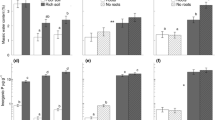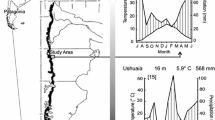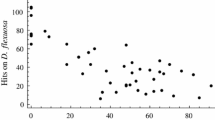Abstract
Two field experiments were conducted using three dominant perennial species of the Chihuahuan Desert: Hilaria mutica (a tussock grass), Larrea tridentata (a microphyllous shrub) and Opuntia rastrera (a flat-stemmed succulent cactus). Two hypotheses concerning competition in arid plant communities were tested. (1) Marked resource partitioning with no interspecific competition could be expected since the three species belong to different life-forms, and that plant growth in deserts is basically limited by harsh environmental conditions. (2) Alternatively, resource scarcity (particularly water) will result in strong plant competition. In a 1-year removal experiment, water status and plant growth of the three species were monitored in twelve 10 m × 10 m plots randomized in three blocks and assigned to the following treatments: (a) removal of all species, except H. mutica; (b) removal of all species, except L. tridentata; (c) removal of all species, except O. rastrera, and (d) control without any manipulation. In a watering experiment, under two neighbourhood conditions (growing isolated or in associations of plants of the three species in plots of 20 m2), the water status of the three species and the growth of H.mutica and L.tridentata were studied for 32 days after an irrigation equivalent to 30 mm of rain, similar to a strong storm event at the site. In the removal experiment, where plants were free to capture water, no evidence of competition was observed. However, during the watering experiment, in which water was forced into the soil, competitive effects were observed. Associated individuals of L. tridentata had lower xylem water potentials and osmotic potentials (OPs) and produced shorter twigs and less leaves and nodes. Although less pronounced, neighbours also had a negative effect on the OP in O. rastrera. According to these results, the intensity of the interspecific competition for water seems to depend on the level of resource availability in the soil. Thus, the validity of the two hypotheses tested in this study also depends on the level of resources. Competition could be absent or very low in years of low precipitation, as in the year of this study (173 mm against a 25-year average of 264 mm). However, when soil water availability is high, e.g. following heavy rain, the negative interactions between species could be more intense.
Similar content being viewed by others
Author information
Authors and Affiliations
Additional information
Received: 3 October 1997 / Accepted: 23 March 1998
Rights and permissions
About this article
Cite this article
Briones, O., Montaña, C. & Ezcurra, E. Competition intensity as a function of resource availability in a semiarid ecosystem. Oecologia 116, 365–372 (1998). https://doi.org/10.1007/s004420050599
Issue Date:
DOI: https://doi.org/10.1007/s004420050599




